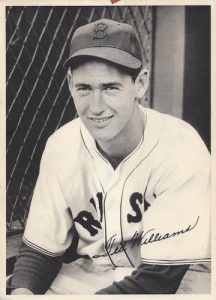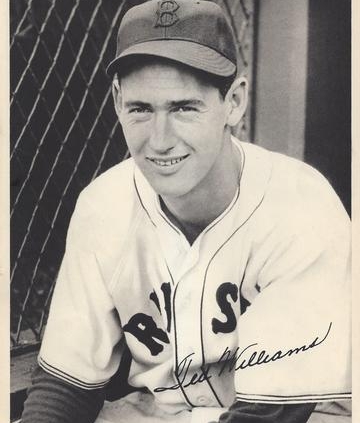May 9, 1939: Red Sox rookie Ted Williams hits game-winning homer in 10th to beat Browns
 In the course of his career, Ted Williams hit 521 major-league home runs. More than 20 percent of them were game-winners.1 His first homer to win a game was in the ninth game of his rookie season of 1939, on May 4 at Briggs Stadium in Detroit. His three-run homer in the top of the fifth — the third home run of his career — gave the Red Sox a 7-4 lead over the Tigers. They held on to win that game, 7-6.
In the course of his career, Ted Williams hit 521 major-league home runs. More than 20 percent of them were game-winners.1 His first homer to win a game was in the ninth game of his rookie season of 1939, on May 4 at Briggs Stadium in Detroit. His three-run homer in the top of the fifth — the third home run of his career — gave the Red Sox a 7-4 lead over the Tigers. They held on to win that game, 7-6.
Williams’s first game-winner in extra innings came five days later in St. Louis.
The early-season Tuesday afternoon game drew only 1,589 — or 2,134 per the St. Louis Globe-Democrat.2 Jack Kramer was starting pitcher for the St. Louis Browns and manager Fred Haney. This was only the fourth start of what became a 12-year major-league career for Kramer; he was 2-0 coming into the game.
Kramer gave up one run in the first inning and one run in the second. Boston center fielder Doc Cramer led off the first with a single. Joe Vosmik grounded out and Ted Williams struck out, but mixed in were walks to Jimmie Foxx, Joe Cronin, and then a bases-loaded walk to third baseman Jim Tabor.
In the second inning, catcher Gene Desautels singled, was sacrificed to second by pitcher Jim Bagby Jr., and then scored on Cramer’s single to left. Once again, Foxx walked and Cronin walked, but Williams again struck out with the bases loaded.
Bagby held the Browns scoreless in both the first and the second.
Kramer continued to struggle in the third inning, walking two more (Tabor and second baseman Bobby Doerr) and giving up singles to Desautels and Bagby. Only one run scored, on Bagby’s hit, because Tabor had been thrown out trying to steal second while Doerr was waiting for his base on balls. Harry Kimberlin relieved Kramer at this point. Doc Cramer made an out, but another run scored in the process. It was 4-0, Red Sox, when Kimberlin got the third out.
The Browns got three runs back in their half of the third. Right fielder Tommy Thompson and shortstop Don Heffner both singled. And so did first baseman George McQuinn, driving in Thompson. Center fielder Myril Hoag bunted to the pitcher, and was safe on Bagby’s throwing error. Heffner scored and McQuinn and Hoag were on third base and second. Harlond Clift lifted a ball caught in foul territory by shortstop (and Red Sox manager) Joe Cronin. Left fielder Beau Bell hit a sacrifice fly to center field, for the third run.
Neither side scored in the fourth or fifth.
The Red Sox extended their lead in the top of the sixth. Cramer walked, Vosmik singled, and Foxx hit a three-run homer “into the distant center-field bleachers,” a shot the Boston Globe’s Gerry Moore estimated at 450 feet.3 Kimberlin closed out the inning, but Boston had a 7-3 advantage.
When Kimberlin was due up in the St. Louis sixth, he was lifted for a pinch-hitter. Bill Trotter was the new pitcher. He kept the Red Sox scoreless in the seventh.
In the bottom of the seventh, the Browns scored twice. With two outs, Clift singled and Bell homered. It was 7-5, Red Sox.
St. Louis rallied for two more runs in the bottom of the eighth and tied the score, thanks to a couple of pinch-hitters. Former Red Sox outfielder Mel Almada pinch-hit for catcher Joe Glenn. He singled off Bagby’s heel. Billy Sullivan pinch-hit for Trotter, swung at the first pitch, and homered onto the roof of the right-field pavilion.4 The game was tied, 7-7.
Joe Heving relieved Bagby and allowed a double to Heffner but got three outs.
Neither side scored in the ninth inning and the game went into extra innings. Ed Cole pitched the top of the ninth without allowing a man on base.5 Heving allowed a single, but no more.
In the top of the 10th, Vosmik singled to right field.6 So did Foxx, who was held to a single on a ball hit off the right-field screen. Cronin struck out and was so angry with himself that, as Moore noted, he nearly threw the bat into the dugout.
Williams batted with two on and one out. He had been slumping. After the game-winning home run he’d hit on May 4, he’d gone 0-for-9 then hit a double on May 7. He had gone 0-for-5 in this game, thus 1-for-15 after the May 4 home run and through the first nine innings of this game. His approach at the plate had drawn some criticism. Burt Whitman of the Boston Herald wrote that Williams had been seen by some as becoming “crippled by a too-obvious home-run swinging complex.”
But this time, Williams’s swing was on target. He homered off Cole, a three-run blow. On a full count, Williams “caught an inside pitch and lined it onto the chummy rightfield roof. It barely cleared the screen.”7 It was 10-7, Red Sox.
Needing three outs to close out the win, Heving retired Sullivan, but Thompson singled (for the fourth time in the game) and Heffner doubled off the right-field pavilion screen. Suddenly, St. Louis had something going.
Fritz Ostermueller relived Heving. McQuinn grounded out, Cronin to Foxx, but Thompson scored on the play. That made it 10-8.
The next day’s starting pitcher, Jack Wilson, was pressed in to duty, replacing Ostermueller. Wilson walked Hoag, putting two on with two outs.
Clift hit a “towering smash” to left-center field. Both Vosmik and Williams made a desperate chase for it.
“With one last effort the speeding Joe [Vosmik] stuck out his glove while still going full tilt. Somehow it landed and stuck in there and the near distraught Cronin threw away his cap and raced out into left field to hug Vosmik.”8 The Red Sox had survived the Browns’ last rally.
The Browns had amassed 17 base hits, but got only two bases on balls. The trio of Thompson, Heffner, and Bell accounted for 10 of the 17 hits. Bell had three RBIs. Browns pitchers gave up 14 hits and walked 10. The only Red Sox player without a hit — excepting the relievers — was Cronin. Foxx and Williams each had three RBIs, all on home runs. Each team left 12 men on base.
In the end, the 10th-inning Williams homer and the former Brownie Vosmik’s catch resulted in a 10-8 win for the Red Sox. The win edged the Red Sox into a near-tie for first place in the American League standings. (They remained behind the Yankees in winning percentage.)
Sources
In addition to the sources cited in the Notes, the author consulted Baseball-Reference.com and Retrosheet.org. Thanks to Carl Riechers for access to the St. Louis Globe-Democrat.
https://www.baseball-reference.com/boxes/SLA/SLA193905090.shtml
https://www.retrosheet.org/boxesetc/1939/B05090SLA1939.htm
Notes
1 Each of Williams’s home runs is described in Bill Nowlin, 521-The Story of Ted Williams’ Home Runs (Cambridge, Massachusetts: Rounder Books, 2013).
2 Martin J. Haley, “Red Sox Trip Browns in Tenth, 10-8, on Williams’ Homer,” St. Louis Globe-Democrat, May 10, 1939: 13.
3 Gerry Moore, “Red Sox Win in 10th to Hold Lead in League,” Boston Globe, May 10, 1939: 25. Haley’s article said Foxx’s homer left the field of play “above the 425-foot mark … one of the longest drives ever hit into that sector.”
4 Associated Press, “Red Sox Beat Browns, 10-8, in 10th, Keep Lead,” Washington Post, May 10, 1939: 21.
5 Cole’s given name was Edward Kisleauskas. Cole was 1-6 in his career, and then bore the loss in this game. He appeared in only three more games, without a decision — one more game in May and then two in September.
6 Vosmik had played just one season for the Browns — 1937 — but hit .325 with 93 runs batted in.
7 Burt Whitman, “Williams’ Homer in 10th with Two On Gives Sox 10-8 Win over Browns,” Boston Herald, May 10, 1939: 15.
8 Moore.
Additional Stats
Boston Red Sox 10
St. Louis Browns 8
10 innings
Sportsman’s Park
St. Louis, MO
Box Score + PBP:
Corrections? Additions?
If you can help us improve this game story, contact us.


